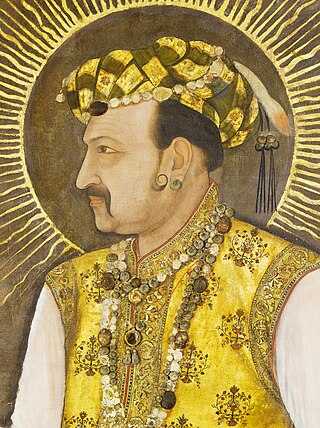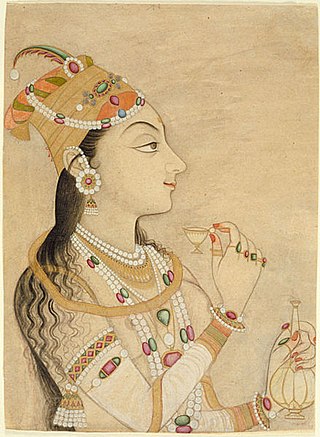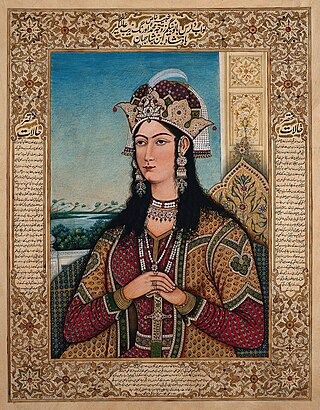Related Research Articles

Nasir al-Din Muhammad, commonly known by his regnal name Humayun, was the second Mughal emperor, who ruled over territory in what is now Eastern Afghanistan, Bangladesh, Northern India, and Pakistan from 1530 to 1540 and again from 1555 to his death in 1556. At the time of his death, the Mughal Empire spanned almost one million square kilometers.

Nur-ud-Din Muhammad Salim, known by his imperial name Jahangir, was the fourth Mughal Emperor, who ruled from 1605 till his death in 1627.

Mirza Shahab-ud-Din Muhammad Khurram, also known as Shah Jahan I, was the fifth Mughal emperor, reigning from 1628 until 1658. During his reign, the Mughals reached the peak of their architectural and cultural achievements.
Mughal or Moghul may refer to:

The Taj Mahal is an ivory-white marble mausoleum on the right bank of the river Yamuna in Agra, Uttar Pradesh, India. It was commissioned in 1631 by the fifth Mughal emperor, Shah Jahan to house the tomb of his beloved wife, Mumtaz Mahal; it also houses the tomb of Shah Jahan himself. The tomb is the centrepiece of a 17-hectare (42-acre) complex, which includes a mosque and a guest house, and is set in formal gardens bounded on three sides by a crenellated wall.

Mumtaz Mahal was the empress consort of Mughal Empire from 1628 to 1631 as the chief consort of the fifth Mughal emperor, Shah Jahan. The Taj Mahal in Agra, often cited as one of the Wonders of the World, was commissioned by her husband to act as her tomb.

Jahanara Begum was a princess of the Mughal Empire. She was the second and the eldest surviving child of Mughal Emperor Shah Jahan and Mumtaz Mahal.

Nur Jahan, born Mehr-un-Nissa was the twentieth wife and chief consort of the Mughal emperor Jahangir.

The Red Fort or Lal Qila is a historic fort in the Old Delhi neighbourhood of Delhi, India, that historically served as the main residence of the Mughal emperors. Emperor Shah Jahan commissioned construction of the Red Fort on 12 May 1639, when he decided to shift his capital from Agra to Delhi. Originally red and white, its design is credited to architect Ustad Ahmad Lahori, who also constructed the Taj Mahal. The fort represents the peak in the Mughal architecture under Shah Jahan and combines Persian palace architecture with Indian traditions.

The Bibi Ka Maqbara is a tomb located in the city of Aurangabad in the Indian state of Maharashtra. It was commissioned in 1660 by the Mughal emperor Aurangzeb's son prince Azam Shah in the memory of his loving mother Dilras Banu Begum. It bears a striking resemblance to the Taj Mahal, the mausoleum of Aurangzeb's mother, Mumtaz Mahal and that is why it is also called the Taj of the Deccan. Aurangzeb was not much interested in architecture though he had commissioned the small, but elegant, Moti Masjid at Delhi. Bibi Ka Maqbara is the second largest structure that Aurangzeb has built, the largest being the Badshahi Mosque.
Ebba Koch is an Austrian art and architectural historian, who defines and discusses cultural issues of interest to political, social and economic historians. Presently she is a professor at the Institute of Art History in Vienna, Austria and a senior researcher at the Austrian Academy of Sciences. She completed her doctorate in philosophy and her Habilitation at Vienna University.

The Nawab of Awadh or the Nawab of Oudh was the title of the rulers who governed the state of Awadh in north India during the 18th and 19th centuries. The Nawabs of Awadh belonged to an Iranian dynasty of Sayyid origin from Nishapur, Iran. In 1724, Nawab Sa'adat Khan established the Oudh State with their capital in Faizabad and Lucknow.
Moghuls may refer to:

The Mughal Empire was an early modern empire in South Asia. At its peak, the empire stretched from the outer fringes of the Indus River Basin in the west, northern Afghanistan in the northwest, and Kashmir in the north, to the highlands of present-day Assam and Bangladesh in the east, and the uplands of the Deccan Plateau in South India.
The Great Moghuls is a 1990 Channel 4 documentary series covering the dramatic story of the rise of the Moghul Empire (1526–1857) of India. Over six generations, from father to son, the Great Moghuls captured, consolidated and profoundly influenced control of the sub-continent of India. The six-part series was written and presented by Bamber Gascoigne based upon his 1971 book of the same name. It was produced and directed by Douglas Rae and filmed on location in India.

Dilras Banu Begum was the first wife and chief consort of Emperor Aurangzeb, the sixth Mughal emperor. She is also known by her posthumous title, Rabia-ud-Durrani. The Bibi Ka Maqbara in Aurangabad, which bears a striking resemblance to the Taj Mahal, was commissioned by her husband to act as her final resting place.

Empire of the Moghul is a series of historical fiction novels written by Alex Rutherford. The series consists of six volumes covering the rise and height of the Moghul Empire in medieval India.

Manavati Bai, also spelled Manvati Bai,, better known by her title, Jagat Gosain, was the second wife and the empress consort of the fourth Mughal emperor Jahangir and the mother of his successor, Shah Jahan.

The Empire is an Indian period drama television series created by Nikkhil Advani and directed by Mitakshara Kumar based on the novel series Empire of the Moghul by Alex Rutherford for Disney+ Hotstar. The series was premiered on Disney+ Hotstar on 27 August 2021.
References
- ↑ "Alex Rutherford". Macmillan Publishers.
- 1 2 "Alex Rutherford". Goodreads.
- ↑ "Empire of the Moghul". Macmillan Publishers.
- 1 2 "Interview : Diana Preston". The Hindu . 2010-04-18. Archived from the original on 2010-04-21.
- ↑ Rutherford, Alex (2019-02-23). "Writing history". The Hindu. ISSN 0971-751X . Retrieved 2019-04-08.
- ↑ "Raiders from the North written by Alex Rutherford". Archived from the original on 2014-07-11. Retrieved 2014-01-31.
- ↑ Empire of the Moghul: Ruler of the World by Alex Rutherford | Review | Historical Novels Review
- ↑ Book review: 'Empire of The Moghul: The Tainted Throne' | Latest News & Updates at Daily News & Analysis
- ↑ Books | Alex Rutherford | Reviews | Time Out Mumbai